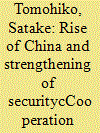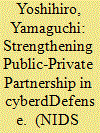|
|
|
Sort Order |
|
|
|
Items / Page
|
|
|
|
|
|
|
| Srl | Item |
| 1 |
ID:
170529


|
|
|
|
|
| Summary/Abstract |
The Treaty on the Prohibition of Nuclear Weapons (TPNW) was adopted by the United Nations in
July 2017 with the support of nearly two-thirds of the international community, despite opposition
between nuclear weapon states and nuclear umbrella states on how to proceed with nuclear
disarmament. Although the TPNW’s preamble details its relationship with pre-existing treaties, a
number of problems have been pointed out vis-à-vis the Treaty on the Non-Proliferation of Nuclear
Weapons (NPT) and the Comprehensive Nuclear-Test-Ban Treaty (CTBT). Additionally, analysis
of the issues identified in the TPNW negotiations by the nuclear weapon states and the nuclear
umbrella states suggests that they can be roughly aggregated into: i. The issue of the involvement of
nuclear weapon states, ii. Concerns about the division of the international community, iii. Nuclear
deterrence considerations, iv. Awareness of an increasingly severe international security environment,
v. Warning about the risk of weakening the NPT system (concerns about compatibility with existing
treaties), and vi. Inadequacies in verification mechanisms. The challenge for nuclear arms control and
disarmament in the era of TPNW discussions is to find answers for these issues. It will become ever
more important to consider the essential issues around nuclear deterrence and nuclear disarmament
in order to facilitate constructive consensus-building among all concerned parties, looking ahead to
the 2020 NPT Review Conference.
|
|
|
|
|
|
|
|
|
|
|
|
|
|
|
|
| 2 |
ID:
170528


|
|
|
|
|
| Summary/Abstract |
The development of AI, which first began in the 1950s, has been carried out in a way that explores
the logical thinking of humans using deductive or inductive inference, but this approach has become
the potential and limitations of AI. The introduction of AI by the military, whose full-fledged trials
began in the Second Boom of AI development in the 1970s, has today reached a level where AI can
replace the thinking and decision making related to the command structure (military personnel).
The introduction of such high performance AI will likely have a major impact on approaches to the
military (structure and organization). However, AI, which was developed in pursuit of human logical
thinking, faces with the weak point of “ad hoc response to inexperienced situations.” However, such
response is always required of the military (military personnel) on the battle front or at the scene of
disasters. When viewed in this light, the ideal approach of the military (military personnel) for coexistence with AI comes into focus.
|
|
|
|
|
|
|
|
|
|
|
|
|
|
|
|
| 3 |
ID:
170530


|
|
|
|
|
| Summary/Abstract |
This paper will analyze why and how US-Japan-Australia security cooperation developed in the
2000s, mainly from the allied perspective (Japan and Australia). Existing literature notes that the
United States aimed to form an alliance opposing China from the start of the 2000s by strengthening
relationships with its allies. In contrast, Japan and Australia’s perception of China was different to
that of the United States. This especially applied to Australia, geographically distant from China,
which prioritized strengthening its relations with China through diplomacy and trade over direct
antagonism. Regardless of this, both Japan and Australia worked to strengthen security cooperation
between Japan, the United States, and Australia based on a strategy of “supplementing” the United
States’ regional and global role by furthering cooperation between its allies in peacekeeping operations
and non-traditional areas of security. The strengthening of security cooperation between Japan, the
United States, and Australia during the 2000s developed in order to maintain and enhance the United
States’ presence based on the “hub and spokes” alliance system, rather than to directly oppose China
|
|
|
|
|
|
|
|
|
|
|
|
|
|
|
|
| 4 |
ID:
170531


|
|
|
|
|
| Summary/Abstract |
This paper looks at Japan’s cybersecurity policies while placing the focus on the defense of critical
infrastructure that is directly related to national security, and examines the measures that need to be
put in place going forward in regard to public-private partnership initiatives. Firstly, it takes a broad
overview of Japan’s policies followed by an overview of the cybersecurity policies of the Republic
of Estonia, and carries out a comparison with Japan based on the following six classifications:
cybersecurity strategy, legal systems, public-private partnership organizations and informationsharing systems, risk analysis and business continuity plans, cyber exercises, and national defense
strategy and organizations. Then, the feasibility of implementation in Japan is considered. Finally, it
makes the following recommendations: (1) Positioning the protection of critical infrastructure as the
most important issue in the cybersecurity strategy; (2) Reviewing the legal system and strengthening
the supervision and guidance of critical information infrastructure (CII) operators; (3) Strengthening
the authority of the National center of Incident readiness and Strategy for Cybersecurity (NISC), and
enhancing its functions; (4) Implementing exercises in preparation for a large-scale cyberattack at the
national level; (5) Building a framework that enables civilians with advanced skills to participate in
national defense in cyberspace.
|
|
|
|
|
|
|
|
|
|
|
|
|
|
|
|
| 5 |
ID:
170532


|
|
|
|
|
| Summary/Abstract |
This research discusses why Japan’s “Basic Defense Force Concept” adopted earlier was maintained
amidst the widely-discussed demise of détente and the arrival of the “Second Cold War” between the
United States and the Soviet Union entering the 1980s. From the perspective that perceives the Basic
Defense Force Concept as a “beyond-the-threat theory,” the defense controversies that unfolded
during the Second Cold War were waged between the Basic Defense Force Concept and criticisms
of the Basic Defense Force Concept resembling the “counter-threat theory” based on the increasing
threat recognition. As a result, the Basic Defense Force Concept was not abandoned, which probably
might finish with the victory of the Basic Defense Force Concept against the “counter-threat
theory.” However, that was actually not the case. The Basic Defense Force Concept began to coexist
with the “Idea of Defense Force Reinforcement,” a competing theory to the Basic Defense Force
Concept that took prominence during the Second Cold War, due to the “Idea of Attached Table Early
Achievement” and the “Idea of Attached Table Revision and Concept Change,” considered to be a
competing theory to the Basic Defense Force Concept as well, due to the “Idea of Attached Table
Revision and Concept Continuation.”
|
|
|
|
|
|
|
|
|
|
|
|
|
|
|
|
|
|
|
|
|